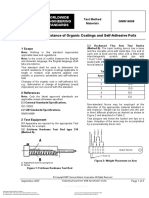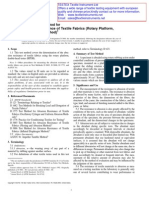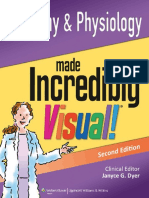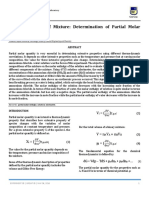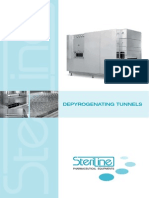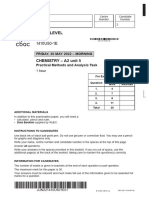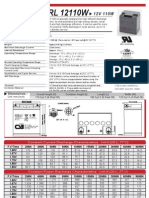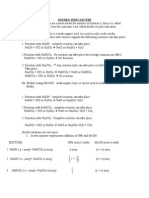Professional Documents
Culture Documents
Ford Laboratory Test Method: Interior Odor Test Application
Ford Laboratory Test Method: Interior Odor Test Application
Uploaded by
Chloe ReyesOriginal Title
Copyright
Available Formats
Share this document
Did you find this document useful?
Is this content inappropriate?
Report this DocumentCopyright:
Available Formats
Ford Laboratory Test Method: Interior Odor Test Application
Ford Laboratory Test Method: Interior Odor Test Application
Uploaded by
Chloe ReyesCopyright:
Available Formats
FORD LABORATORY TEST METHOD
BO 131-03
INTERIOR ODOR TEST
Application
This test method is used to determine the odor originating from interior trim materials/components/assemblies in
the passenger or luggage compartment or from parts or ducting that convey air into the passenger
compartment.
Apparatus and Materials Required
Mechanical Convection Ovens
Capable of maintaining a temperature of 80 +/- 2 °C.
3-Litre Odorless Preserving Jar with Lid
Dimensions of jar: approximately 250mm high x 125 mm diameter; neck 100mm diameter. The jar and
any seals it may employ must be odorless. A suitable odorless material for the jar seals is Polyethylene
closed cell foam 3mm thick of 45kg/m3 density
Suitable suppliers for jars of this type are:
VMC French Flint and Ormco Ltd.
505 E. Main Street 61 St Thomas Street
Carnegie, PA 15106 London
TEL: +1 412 279 3145 SE1 3QX
FAX: +1 412 279 3910 TEL: +44 (0)207 403 1733
FAX: +44 (0)207 407 5877
Suitable supplier of material for making jar seals is:
RS Components Ltd
Birchington Road,
Corby, Northants, NN17 9RS, UK
TEL: +44 (0)1536 201201
FAX: +44 (0)1536 201501
(order stock number 303 2274)
Stainless Steel Wire Ring/Support Frame
The above material is available from any reputable laboratory equipment supply house.
Distilled or Deionized Water
20 microohms/cm at 25 °C maximum conductivity (ASTM D 1125)
Sample Preparation
The volume and number of samples is determined using Table 1 below. The choice of variants A, B or C is
based upon the volume content of each material used in the vehicle interior.
Date Action Revisions
2009 02 03 Revised J Williams, FOE
2007 06 07 Activated --`,,,`,,``,,`,,``,,,`,`````,,,`-`-`,,`,,`,`,,`---
J.Williams
Printed copies are uncontrolled
Copyright Ford Motor Company
Provided by IHS under license with FORD
Copyright © 2009, Ford Global Technologies, LLC
Licensee=3M Company/5915980100
Page 1 of 4
No reproduction or networking permitted without license from IHS Not for Resale, 05/10/2010 11:12:42 MDT
FORD LABORATORY TEST METHOD
BO 131-03
TABLE 1
Variant Application Sample Volume/Size
A Clips, plugs, covers and other (30 +/- 3) g
small parts
B Armrests, ashtrays, door (60 +/- 6) cm3
handles, shift lever gaiters, sun
visors, door/window seals and
other medium-size parts
C Seat/roof covers, sound- 3 each of 90mm X 200mm
deadeners, foils, leather, foam (in same jar)
materials, carpets, ducting and
other large surface materials
Note: For material testing, select variant per intended part application. For materials used in several
applications, test to largest application variant.
If the material thickness of a homogeneous material is more than 20 mm, then the sample is to be prepared for
a 20 mm thickness. Sandwich materials must be tested in their compound state. If the parts are small, use
several pieces to satisfy the specified sample volume or weight requirements.
Conditioning of Materials and Test Conditions
All test values indicated herein are based on material conditioned in a controlled atmosphere of 23 +/- 2 °C and
50+/-5% relative humidity, for not less than 24 hours prior to testing, and tested under the same conditions
unless otherwise specified.
All samples must be tested between 14-28 days of part manufacture.
Procedure
1. Clean the jars, lids (using laboratory washing machines) and seals (hand wash) before each use. They
must be clean and odorless.
2. Add 50 ml of distilled or deionized water (required for conditions 1 &2) to the jar. Take a stainless steel
--`,,,`,,``,,`,,``,,,`,`````,,,`-`-`,,`,,`,`,,`---
wire ring or support, suspend or stand the samples, to be tested, in the jar.
Note:
Sample contact should be minimized.
Avoid wetting the samples.
Samples must not touch the water.
3. The jars containing the samples should be conditioned and assessed at three different temperatures as
shown in table 2.
TABLE 2: Summary of Test Conditions
Condition* Temperature Test Time
1 23 +/- 2 °C 24 h +/- 1 h
2 40 +/- 2 °C 24 h +/- 1 h
3 80 +/- 2 °C 2 h +/- 10min
*All 3 conditions are required, using a separate specimen and jar for each.
Printed copies are uncontrolled
Copyright Ford Motor Company
Provided by IHS under license with FORD
Copyright © 2009, Ford Global Technologies, LLC
Licensee=3M Company/5915980100
Page 2 of 4
No reproduction or networking permitted without license from IHS Not for Resale, 05/10/2010 11:12:42 MDT
FORD LABORATORY TEST METHOD
BO 131-03
Condition 1:
Add 50ml of distilled or deionized water is to the jar.
The samples is/are placed into the jar in such a way that to prevent contact with the water.
Allow samples to condition in jar for 24 h +/- 1 hr at 23 +/- 2 oC.
The evaluation is made immediately after the removal of the lid from the jar
Condition 2:
Add 50ml of distilled or deionized water is to the jar.
The samples is/are placed into the jar in such a way that to prevent contact with the water
The jar is closed and stored in the pre-heated oven for 24 h +/- 1 hr at 40 +/- 2 oC.
The evaluation is made immediately after removal of the jar from the oven. Place jars in the
oven for 15 minutes between odor assessments.
Condition 3:
Place samples in the jar.
The jar is closed and stored in the pre-heated oven for 2 h +/- 10 min at 80 +/- 2 oC .
The jar is removed from the oven and is placed in a second pre-heated oven for 30 minutes at
60 +/- 5 °C prior to the evaluation. Return the jars to the original pre-heated oven at 80 +/- 2 oC
for 15 minutes between odor assessments.
4. The assessors should be selected from staff who do not work in the production facility. Heavy smokers,
users of strong aromatic perfumes or people with sinus problems are not suitable. Acceptance tests shall
be made by at least three assessors. The measurement shall be repeated by at least five assessors if the
rating of individual tests differs by more than two points.
a. The lid should be removed (samples remain in jar) and the first assessor's nose should be
positioned about 2 - 3 cm from the jar.
b. The assessor should slowly inhale.
--`,,,`,,``,,`,,``,,,`,`````,,,`-`-`,,`,,`,`,,`---
c. Record the appropriate rating (refer to "Odor Rating" on Page 3).
d. The lid should not be off the jar longer than 5 seconds.
e. The test must be conducted in an environment free from drafts and contaminant odors.
5. Repeat Step 4 for each sample.
Copyright Ford Motor Company
Provided by IHS under license with FORD
Printed copies are uncontrolled Copyright © 2009, Ford Global Technologies, LLC
Licensee=3M Company/5915980100
Page 3 of 4
No reproduction or networking permitted without license from IHS Not for Resale, 05/10/2010 11:12:42 MDT
FORD LABORATORY TEST METHOD
BO 131-03
6. The odor rating is indicated by the arithmetic mean of all the assessors individual rating, the value being
rounded to the nearest half point.
For all the variants and conditions, the odor evaluation uses the rating of 1 to 6, with half-point ratings,
as follows:
Rating Scale
Rating 1 not perceptible
Rating 1.5
Rating 2 perceptible, not disturbing
Rating 2.5
Rating 3 clearly perceptible but not disturbing
----------------------------------------------------
Rating 3.5
Rating 4 disturbing
--`,,,`,,``,,`,,``,,,`,`````,,,`-`-`,,`,,`,`,,`---
Rating 4.5
Rating 5 strongly disturbing
Rating 5.5
Rating 6 extremely disturbing
7. A rating of 3 or less for all test conditions in Table 2 is acceptable. The test report shall include:
f. A reference to this standard.
g. All necessary details for identifying the test samples.
h. Material variant classification (A, B or C) from Table 1.
i. Test condition.
j. Names of assessors and their ratings for each test condition in table 2.
k. Special characteristics of the test samples and their condition.
l. Date of manufacture of the samples and the date of the test.
Example of the test result designation:
Designation Test Method Test Variant Test Condition Rating
Odor Test FLTM BO131-03 B 2 3
Chemicals, materials, parts, and equipment referenced in this document must be used and handled properly.
Each party is responsible for determining proper use and handling in its facilities.
Printed copies are uncontrolled
Copyright Ford Motor Company
Provided by IHS under license with FORD
Copyright © 2009, Ford Global Technologies, LLC
Licensee=3M Company/5915980100
Page 4 of 4
No reproduction or networking permitted without license from IHS Not for Resale, 05/10/2010 11:12:42 MDT
You might also like
- Test Method of Flammability of Interior Materials For AutomobilesDocument17 pagesTest Method of Flammability of Interior Materials For AutomobilesKarthic BhrabuNoch keine Bewertungen
- ASTM D5420-04 - Gardner - Impact Resistance of Flat Rigid Plastic Specimen PDFDocument8 pagesASTM D5420-04 - Gardner - Impact Resistance of Flat Rigid Plastic Specimen PDFMehdi Gouader0% (1)
- Gravimetric Determination of Condensable Components: Group StandardDocument6 pagesGravimetric Determination of Condensable Components: Group Standardthiagomcasimiro100% (1)
- Test Method: Renault Automobiles Standardisation DPMI / Service 67250 Section Normes Et Cahiers Des ChargesDocument13 pagesTest Method: Renault Automobiles Standardisation DPMI / Service 67250 Section Normes Et Cahiers Des ChargesJose ValenciaNoch keine Bewertungen
- TL 226 en 2018Document13 pagesTL 226 en 2018Michal BílekNoch keine Bewertungen
- Testing Methods of Chemical Resistance For Plastic Parts: Nissan Engineering StandardDocument13 pagesTesting Methods of Chemical Resistance For Plastic Parts: Nissan Engineering StandardDiego Camargo100% (1)
- M0007 - 2014-1 Testing Method For Automotive PaintDocument164 pagesM0007 - 2014-1 Testing Method For Automotive PaintErick Hernández0% (1)
- Worldwide Engineering Standards: Stone Impact Resistance of CoatingsDocument6 pagesWorldwide Engineering Standards: Stone Impact Resistance of CoatingsAlondra CVNoch keine Bewertungen
- GMW14698 ArranhõesDocument7 pagesGMW14698 ArranhõesRicardo F. SNoch keine Bewertungen
- Linear Dimensional Changes of Nonrigid Thermoplastic Sheeting or Film at Elevated TemperatureDocument2 pagesLinear Dimensional Changes of Nonrigid Thermoplastic Sheeting or Film at Elevated TemperaturePyone Ei ZinNoch keine Bewertungen
- GMW15058 May 2015Document13 pagesGMW15058 May 2015Anonymous 8Z2HZ5JP7Noch keine Bewertungen
- Worldwide Engineering Standards: Procedures For High Humidity TestDocument3 pagesWorldwide Engineering Standards: Procedures For High Humidity TestAkmal NizametdinovNoch keine Bewertungen
- Worldwide Engineering Standards: Tape Adhesion Test For Paint FinishesDocument9 pagesWorldwide Engineering Standards: Tape Adhesion Test For Paint FinishesAkmal NizametdinovNoch keine Bewertungen
- Worldwide Engineering Standards: Stone Impact Resistance of CoatingsDocument3 pagesWorldwide Engineering Standards: Stone Impact Resistance of CoatingsAnvarbek KarimovNoch keine Bewertungen
- EX-GM-006 - GMW 14698 - 200709 - EN - Scratch Resistance of Orangnic Coatings and Self-Adhesion Foils PDFDocument3 pagesEX-GM-006 - GMW 14698 - 200709 - EN - Scratch Resistance of Orangnic Coatings and Self-Adhesion Foils PDFEd RiNoch keine Bewertungen
- Astm D648 HDT PDFDocument13 pagesAstm D648 HDT PDFEva SilvaNoch keine Bewertungen
- Sheehan 06 PDFDocument8 pagesSheehan 06 PDFpalani.djpNoch keine Bewertungen
- Astm D3884-Abrasion Taber TestDocument5 pagesAstm D3884-Abrasion Taber TestGreeshmaNoch keine Bewertungen
- Iso 3537-1999Document6 pagesIso 3537-1999Anovar_ebooks0% (1)
- Test Method: Renault Automobiles Standardisation DQSC - S / Department 00621 Section Normes Et Cahiers Des ChargesDocument9 pagesTest Method: Renault Automobiles Standardisation DQSC - S / Department 00621 Section Normes Et Cahiers Des Chargesclaudio5475Noch keine Bewertungen
- FLTM BP 101-01 Rubber Ozone ResistanceDocument10 pagesFLTM BP 101-01 Rubber Ozone ResistanceFrancesco VignaliNoch keine Bewertungen
- Iso - 815-1 (2019)Document20 pagesIso - 815-1 (2019)Chloe Reyes100% (5)
- Refractory Material SelectionDocument7 pagesRefractory Material SelectionCristhofer HernandezNoch keine Bewertungen
- Foundry and Casting OperationDocument176 pagesFoundry and Casting OperationABHINAV KUMAR ROY100% (26)
- Engineering Material Specification: Controlled Document at Page 1 of 6Document6 pagesEngineering Material Specification: Controlled Document at Page 1 of 6erik0007Noch keine Bewertungen
- Astm D 3767Document8 pagesAstm D 3767jackie wang100% (1)
- WSS-M2D507-B4 02d507b5 - ElastomerDocument6 pagesWSS-M2D507-B4 02d507b5 - ElastomerFrancesco VignaliNoch keine Bewertungen
- PV 1303 enDocument8 pagesPV 1303 enpriscilaNoch keine Bewertungen
- Insulating Material PV 3357: KonzernnormDocument7 pagesInsulating Material PV 3357: Konzernnormerik0007Noch keine Bewertungen
- Performance Requirements For Engine Compartment Plastic PartsDocument5 pagesPerformance Requirements For Engine Compartment Plastic PartsAkmal Nizametdinov100% (1)
- GMW14829 AderenciaDocument8 pagesGMW14829 AderenciaRicardo F. SNoch keine Bewertungen
- Determining The Resistance To Odor Propagation of Interior MaterialsDocument7 pagesDetermining The Resistance To Odor Propagation of Interior MaterialsJefferson CruzNoch keine Bewertungen
- Worldwide Engineering Standards: Tape Adhesion Test For Paint FinishesDocument3 pagesWorldwide Engineering Standards: Tape Adhesion Test For Paint FinishesRicardo Bavasso100% (1)
- WSS M8P16 BDocument16 pagesWSS M8P16 Berik0007Noch keine Bewertungen
- Methods of High Temperature Test For Passenger Compartment Synthetic Resin PartsDocument10 pagesMethods of High Temperature Test For Passenger Compartment Synthetic Resin PartsKarthic BhrabuNoch keine Bewertungen
- D 5628 - 96 R01 - Rdu2mjg - PDFDocument10 pagesD 5628 - 96 R01 - Rdu2mjg - PDFJuan Pablo ApazaNoch keine Bewertungen
- ISO 8510-2 - Adhesives Peel Test For A Flexible-Bonded-To-Rigid Test Specimen Assembly 180° Peel 12-1-2006Document12 pagesISO 8510-2 - Adhesives Peel Test For A Flexible-Bonded-To-Rigid Test Specimen Assembly 180° Peel 12-1-2006axeldanyNoch keine Bewertungen
- Astm E96-96m 2014Document13 pagesAstm E96-96m 2014tsalemnoushNoch keine Bewertungen
- WSS M16J19 BDocument10 pagesWSS M16J19 BJuan Angel DechimaNoch keine Bewertungen
- Resistance To Fuels of Exteriors Automotive Materials and ComponentsDocument6 pagesResistance To Fuels of Exteriors Automotive Materials and ComponentsAnvarbek KarimovNoch keine Bewertungen
- D271389 F' PDFDocument13 pagesD271389 F' PDFReza AbdolahiNoch keine Bewertungen
- Psa D 271571 2003Document9 pagesPsa D 271571 2003KasraNoch keine Bewertungen
- Quality Assurance of Pressure-Sensitive Tapes: Standard Practice ForDocument6 pagesQuality Assurance of Pressure-Sensitive Tapes: Standard Practice ForYoga PradanaNoch keine Bewertungen
- Astm D925Document6 pagesAstm D925Chloe ReyesNoch keine Bewertungen
- Fogging Characteristics of Trim Materials: Worldwide Engineering StandardsDocument11 pagesFogging Characteristics of Trim Materials: Worldwide Engineering StandardsJefferson CruzNoch keine Bewertungen
- TSM1501G: Toyota Engineering StandardDocument12 pagesTSM1501G: Toyota Engineering StandardMiguel FelipeNoch keine Bewertungen
- Astm D522-D522MDocument5 pagesAstm D522-D522MTEJAS GADKARI100% (1)
- Worldwide Engineering Standards: Neutral Salt Spray (NSS) TestDocument4 pagesWorldwide Engineering Standards: Neutral Salt Spray (NSS) TestAkmal NizametdinovNoch keine Bewertungen
- Abrasion TaberDocument2 pagesAbrasion TaberDiego Fernado AvendañoNoch keine Bewertungen
- D896 PDFDocument3 pagesD896 PDFCris BandaNoch keine Bewertungen
- GMW14669Document10 pagesGMW14669Ricardo F. SNoch keine Bewertungen
- FLTM BJ 126-01Document3 pagesFLTM BJ 126-01GabrielFalconNoch keine Bewertungen
- Silicone Rubber Sheet (General Purpose, Solid)Document2 pagesSilicone Rubber Sheet (General Purpose, Solid)MohamedNoch keine Bewertungen
- Tear Strength of Conventional Vulcanized Rubber and Thermoplastic ElastomersDocument9 pagesTear Strength of Conventional Vulcanized Rubber and Thermoplastic ElastomersPyone Ei ZinNoch keine Bewertungen
- Volkswagen SpecsDocument1 pageVolkswagen SpecsYash KanherkarNoch keine Bewertungen
- D 5656 - 01 - Rdu2ntytmdeDocument6 pagesD 5656 - 01 - Rdu2ntytmdeJOHNNoch keine Bewertungen
- Minimum Performance Requirements For Decorative Chromium Plated Plastic PartsDocument20 pagesMinimum Performance Requirements For Decorative Chromium Plated Plastic PartsJefferson CruzNoch keine Bewertungen
- Conditioning Plastics For TestingDocument4 pagesConditioning Plastics For TestingROHITNoch keine Bewertungen
- Iso 2285Document13 pagesIso 2285Selçuk Tosun100% (1)
- The Saponification Value of An Oil or Fat Is A Measure of The Amount of Potassium HydroxideDocument11 pagesThe Saponification Value of An Oil or Fat Is A Measure of The Amount of Potassium Hydroxidecaxoro1799Noch keine Bewertungen
- R 021 R 2 A 1 eDocument24 pagesR 021 R 2 A 1 egsuoag100% (1)
- Iso 06721-1-2011Document28 pagesIso 06721-1-2011Ha Linh VuNoch keine Bewertungen
- D 1780 - 99 Rde3odaDocument4 pagesD 1780 - 99 Rde3odaMarceloNoch keine Bewertungen
- PV 3942Document15 pagesPV 3942Chloe ReyesNoch keine Bewertungen
- TL - 52337 (2015)Document8 pagesTL - 52337 (2015)Chloe ReyesNoch keine Bewertungen
- International StandardDocument8 pagesInternational StandardChloe ReyesNoch keine Bewertungen
- Astm D925Document6 pagesAstm D925Chloe ReyesNoch keine Bewertungen
- Iso 9237 1999Document9 pagesIso 9237 1999Chloe ReyesNoch keine Bewertungen
- Nat'l Highway Traffic Safety Admin., DOT 571.302: 571.302 Standard No. 302 Flamma-Bility of Interior MaterialsDocument3 pagesNat'l Highway Traffic Safety Admin., DOT 571.302: 571.302 Standard No. 302 Flamma-Bility of Interior MaterialsChloe ReyesNoch keine Bewertungen
- 2021 06 22 PVC Briefing FINALDocument33 pages2021 06 22 PVC Briefing FINALPierluigi GhioneNoch keine Bewertungen
- RKNLKNKL 255Document2 pagesRKNLKNKL 255Adam AdamakoNoch keine Bewertungen
- Anatomy & Physiology Made Incredibly Visual!Document412 pagesAnatomy & Physiology Made Incredibly Visual!Cereal KillerNoch keine Bewertungen
- Seam 226 ADocument4 pagesSeam 226 AJohn Ronnel BulawanNoch keine Bewertungen
- Experiment 5 Partial Molar EnthalpyDocument4 pagesExperiment 5 Partial Molar EnthalpyRicky JayNoch keine Bewertungen
- Chemistry B.SC Final Year Lab Manual - 1 PDFDocument57 pagesChemistry B.SC Final Year Lab Manual - 1 PDFMehul KhimaniNoch keine Bewertungen
- Steriline TunnelDocument8 pagesSteriline TunnelHutHeoNoch keine Bewertungen
- E Book Mosaic HistoryDocument285 pagesE Book Mosaic HistoryMitesh Thakkar100% (4)
- Abta18 - 24latn Opereations Manual PDFDocument16 pagesAbta18 - 24latn Opereations Manual PDFLeonNoch keine Bewertungen
- BATTERY Narada ManualDocument22 pagesBATTERY Narada Manualevanelizan100% (1)
- Lesson 14 Unitary System IIDocument24 pagesLesson 14 Unitary System IIJoshua SmithNoch keine Bewertungen
- Investigation of Strong Acid and Strong BaseDocument8 pagesInvestigation of Strong Acid and Strong BasePamNoch keine Bewertungen
- Aluminium Aluminum 7005 Alloy (UNS A97005)Document2 pagesAluminium Aluminum 7005 Alloy (UNS A97005)Yusuf FauziNoch keine Bewertungen
- Wjec Paper 2Document16 pagesWjec Paper 2NonuNoch keine Bewertungen
- HRL 12110W: Powered byDocument2 pagesHRL 12110W: Powered byMohsen_a57Noch keine Bewertungen
- Random Packing - From Competitive Products To Advanced SolutionsDocument16 pagesRandom Packing - From Competitive Products To Advanced SolutionsdomNoch keine Bewertungen
- A Fabrication Report On AMMCDocument58 pagesA Fabrication Report On AMMCSai RamNoch keine Bewertungen
- Igc 1 Element - 4Document12 pagesIgc 1 Element - 4Dump FacilityNoch keine Bewertungen
- Tenzin 205164Document14 pagesTenzin 205164sonu sabooNoch keine Bewertungen
- Pesticides en PDFDocument28 pagesPesticides en PDFamitNoch keine Bewertungen
- In Vitro Antimicrobial Activity of The Chemical Ingredients of Ranunculus HirtellusDocument7 pagesIn Vitro Antimicrobial Activity of The Chemical Ingredients of Ranunculus HirtellusluyawinNoch keine Bewertungen
- 11 Normal Vs AbnormalCombustionDocument4 pages11 Normal Vs AbnormalCombustionDhananjay BaviskarNoch keine Bewertungen
- ChemistryDocument2 pagesChemistryvijayNoch keine Bewertungen
- Brosur PentensDocument2 pagesBrosur PentensKaldon DarwisNoch keine Bewertungen
- Analysis of Reinforced Concrete Maluos BDocument67 pagesAnalysis of Reinforced Concrete Maluos BAl Patrick Dela CalzadaNoch keine Bewertungen
- Iso 03405-2011Document44 pagesIso 03405-2011ГалинаNoch keine Bewertungen
- Vision GS Test 20 Prelims 2024 @cse - UpdatesDocument66 pagesVision GS Test 20 Prelims 2024 @cse - Updateshamtum7861Noch keine Bewertungen














